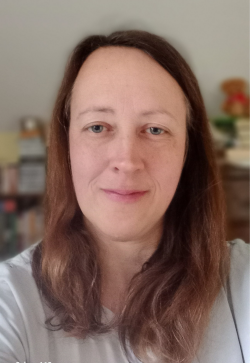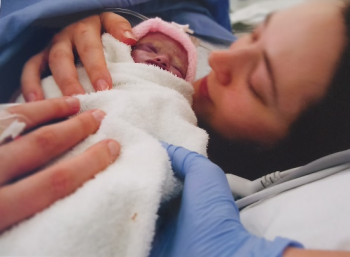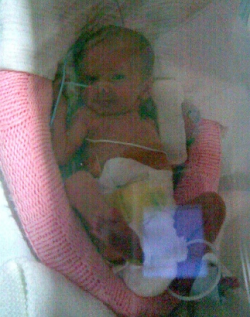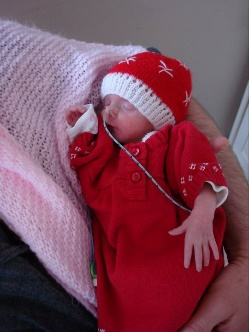AIMS Journal, 2024, Vol 36, No 2
Catharine Hart describes developing pre-eclampsia in pregnancy and an emergency caesarean section with her daughter Eliza being born premature at 32 weeks.

By Catharine Hart
Our first daughter was born 13 years ago at only 32 weeks. She is now a tall high school student, one of the tallest in her year. You would never guess that she weighed only 3lb 3oz (1.44 kg) when she was born. This is her birth story. Although I am sure hospital practices will have changed since this time, I hope it is still of interest to AIMS readers.
Being pregnant as a final-year student midwife was both daunting and exciting at the same time. My husband, family and midwifery lecturers were really supportive, although some of my fellow students seemed a little shocked. One comment was, “Why couldn’t you just have waited?” This from a group of students who were supposed to be regularly reflecting on being non-judgemental and supportive to pregnant women and people in all circumstances.
All seemed well as I excitedly started my pregnancy journey. I even got through the nauseous first trimester without our lodger noticing too much. I remember still feeling quite nauseous at 16 weeks when my sister got married, but pleased that I was still able to wear the 1950s-style dress my sister had chosen alongside the other bridesmaids!
All went well as I settled into my second trimester and began my final year as a student midwife, however, the thought that I could develop pre-eclampsia1 was never far from the back of my mind, as this condition runs in my family. My Mum developed it when pregnant with both my sister and I. She often enjoys recounting the story of my birth when during labour her blood pressure was apparently so high it was ‘off the chart’. Shortly after I was born she was given diazepam (Valium) directly into her bloodstream and rendered unconscious for 24 hours. Thank goodness we have better preventative treatments today.
Because of this, my husband and I were regularly checking my blood pressure at home. When I was just under 32 weeks pregnant we found it had gone up after quite a stressful final shift in my midwifery placement. A day later it still remained high, although, apart from the usual tiredness, I didn’t seem to have any other symptoms. As my next midwifery appointment wasn’t for a few weeks, I rang my community midwifery team and asked if they could fit me in at a clinic “just to check my blood pressure”. I was trying to sound casual, still hoping that with rest and deep breathing my blood pressure readings might go down. However, knowing how quickly things can move in these situations, I quickly packed an overnight bag. I hadn’t previously met the community midwife who was checking my blood pressure, but with a reading of around 170/110 mmHg (the normal level is usually less than 140/90) it was definitely enough for her to act. She didn’t quite fall off her chair, but she immediately asked if we’d please be happy to go into hospital - now! I had a sense that this was the beginning of a series of events which was going to be important, although the idea that our precious daughter could actually be born so soon still hadn’t really occurred to me.
I was still hoping at this point that I could just be given some medication for high blood pressure and sent home. I definitely don’t recall anything like making an informed decision about starting an induction of labour. I really wanted an in-depth discussion about what the actual consequences of going ahead or not could be. I wanted and expected to be treated as an adult, told the actual risks and then to make my own decisions. There was a lot of skirting around the issue and one midwife just barked at me “You have to be realistic”, which definitely left me with more questions than answers.
If I could have the situation again, being treated respectfully, being given full rather than partial information, being trusted to make decisions, and being treated as an adult rather than being infantilised with less than honest information, is what I would want. No matter that I was a student healthcare professional, I was just at sea and experiencing the same emotions as any other parent in this situation. Eventually, however, I agreed to go ahead with induction of labour and the staff (some of whom were familiar to me) were then very compassionate about the situation, even humouring my attempts to bounce on a birthing ball to get labour going.
Things were fine initially, but soon after my waters were broken, Eliza’s heartbeat started to show signs of foetal distress on the monitor, a situation which I was all too familiar with as a student midwife. At this time, the staff responded quickly and professionally and explained clearly to me that an emergency caesarean section was now on the cards; I certainly consented this time. It was clearly a well-rehearsed scenario and I always felt the team were keeping Eliza and I safe. Everything happened very quickly, I remember being given a spinal anaesthetic which meant I could no longer feel the cramps of early labour and was able to stay awake for the operation. My cervix had now dilated to 3cm, which I was very proud of. I was also glad to have experienced something of labour - although now I have actually experienced full-blown labour, I feel this was more like ‘paddling in the shallow end of a swimming pool’!
Our ‘belly birth’2 was a success. Eliza’s cry came through loud and clear and I felt strongly from then on that everything was going to be ok. We had a small cuddle, although not skin-to-skin. It was one of the best minutes of my life, shortly to be followed by one of the hardest; I knew that Eliza would have to be taken away from us. With an incubator at the ready, off she was whisked to the neonatal intensive care unit. In those days incubators were thought to always be better ‘heaters’ than Mum’s and Dad’s chests. Thank goodness we know better now3 that this isn’t always the case, even for premature babies.4

The first moment I was able to meet my daughter, all the more precious because I knew it would not be for long
One episode which still makes my blood boil was my first ever visit to the neonatal unit to see my newborn daughter, less than 24 hours after her birth. I understand it is common for neonatal units to be described as ‘co-located’ with maternity wards if they are fairly near each other. It certainly doesn’t feel very ‘co-located’ when you have to travel down two public corridors to see your newborn baby. I was so excited to finally see our daughter again, but I was met at the door and simply told, “there is a ward round on at the moment - can you come back later?”. I still find it quite unbelievable and infuriating that this happened.
Of course there is a need for confidentiality during ward rounds. But all parents should be given access to their own children in neonatal units; for 24 hours a day, unless there is a very good reason. I am glad to see the latest National Institute for Health and Care Excellence (NICE) guidance now recommends that parents should attend ward rounds and be involved in discussing their own children’s care.5 Dr Nils Bergman, an international expert in neonatal care and skin-to-skin contact, writes, “Parental absence has been strictly enforced in neonatal care units for many reasons and could lead to toxic stress”.6 It felt that parents had been excluded intentionally or ‘by design’ from the unit - shouldn’t every incubator or cot have a chair nearby for parents or caregivers as standard, for example? Nearly all the adult beds in the hospital do, yet for the youngest ‘patients’ this seems to be forgotten.

Eliza in intensive care
I found the noise and bustle of the postnatal ward an unwelcome distraction from recovery. We lived very near the hospital, and I was very thankful to be allowed home after only a few days. I soon learnt that many of the other parents visiting the unit were undertaking much, much longer journeys to see their babies, often daily. The tiny milk expressing room on the unit had been designed with no windows (one-way glass, anyone?), presumably to give women privacy. To me it felt like being trapped and tears certainly flowed more easily than milk at this stage. I was given odd looks when I tried instead to sit next to Eliza’s incubator holding a colostrum syringe, desperately trying to hand express a few drops of colostrum. Now, having breastfed four children, I would be much more forthcoming in this kind of situation, and know that expressing or breastfeeding often needs little more than a baggy T-shirt and a dose of confidence!7 Another thing which sticks in my mind from this time were the continual, loud noises of the baby monitor machines “Beep beep, beep beep, beep beep beep BOING”. These sounds would constantly remain echoing in my head later in quiet moments, after I had returned home.
Our daily visits to the neonatal unit were punctuated by my attempts to express breastmilk, with the added pressure that Eliza had to be given infant formula because I wasn’t able to express enough breastmilk for her ‘requirements’. We weren’t lucky enough to be at one of the neonatal units in the UK with an onsite donor milk bank.8 I was given good support to express milk, but it was always a struggle for me at this time. This led to Eliza being given a mixture of infant formula and my expressed milk. Unfortunately, when she was three weeks old, Eliza developed the dreaded necrotising enterocolitis (NEC), potentially a really serious condition. My Mum, who had just retired from work, met me at the hospital and I immediately burst into tears. This was probably the most worrying time of our whole premature baby experience. We were very lucky though; after some antibiotics and 24 hours of ‘starvation’ with only a dummy to comfort her, everything seemed to settle and her very swollen tummy started to return to a more normal size.
After this bump in the road, however, Eliza didn’t look back. There were three rooms in the unit and she was moved from the highest intensity room into the middle room, then finally to the last room, where she had an open cot instead of an incubator.
What were the highlights of our care? Moments of humour definitely helped. The nurse who joked to me that little premature babies "look like scrawny chickens" made me laugh and spawned a new nickname for our daughter – "Lyzee chicken" – which stuck for several years afterwards!!! One nurse, who I will call A, really stood out for having the kindest attitude. She was there when I stayed overnight in the unit, a few days before we were due to finally bring Eliza home. It was strange that having longed so much to have our baby girl back home, when the time actually came, the idea of being fully responsible for her seemed in some ways quite intimidating. My entire experience of parenthood, up until then, had involved hospital visits, other people caring for our daughter, expressing milk, and me getting over 6 hours of sleep a night! This nurse, A, brought Eliza to me and, with a huge amount of patience, slowly explained to me how I would be able to care for her. No question felt too silly and I felt very reassured. We are lucky to have a friend who was a neonatal nurse on this unit, so I have been able to keep a connection with A and we have met a few times since. What she did for me and for us as a family, and what it meant and means to us, really goes beyond words; it still brings tears to my eyes to this day.
Other staff members, unfortunately, didn’t show quite the same attitude. They seemed more interested in themselves than what was happening around them. On Christmas day, the main priority of the nurse looking after our daughter was telling everyone how her husband always brought her a new second-hand car for Christmas and how she would be upgrading to a Mercedes this year!!

Cuddles on Christmas Day – Eliza came home the next day, complete with the feeding tube
Eliza was finally released from hospital on Boxing Day, complete with a feeding tube in her nose that she loved to pull out (we had to return to get it refitted!). After the second ‘pull-out’, five days after coming home, we were told that she was now gaining weight well enough that we could finally ditch the tube, which was a huge relief.
Lots and lots of skin-to-skin and breastfeeding followed and I finally felt that I could heal from what had happened. Looking back now, she seems so absolutely tiny, but at the time this seemed entirely normal, especially with her being my firstborn. Because she had been born so early we were totally unprepared with baby clothes or anywhere for her to sleep at first either. I was very relieved to be allowed to drive again after my postnatal check and my first mission was to seek out some of the tiniest of baby clothes for her. Friends and family also knitted some of the sweetest and tiniest cardigans I have ever seen, kept as precious mementos, and the unit also kindly donated to us anything which was hard to find.
Eliza may not remember much of her experience but she still has scars on her hands from needles that can be seen to this day. Having a premature baby is an experience I wouldn’t wish on anyone, but I can only hope, one day, that true ‘co-location’ or couplet care (where babies are cared for alongside their Mums or Dads 24 hours a day)9, 10, 11 really happens for many more premature babies (yes, this might mean a complete redesign of neonatal units, but I remain idealistic!). I would love to hear from anyone with an interest in these issues.
Further Reading
I would recommend these books to anyone who has been through the premature birth experience, both are full of hope and positivity with lovely illustrations - and without too many wires!
Nolan, L (2015), Peanut: A storybook for mighty preemie babies (Omaha: Lindsay Nolan)
Watson, J (2016), Soon (USA: Four plus and Angel)
Author Bio: Catharine Hart studied biology at the University of York and later trained as a midwife at the University of East Anglia. She is an AIMS volunteer and a member of the Campaigns Team. She lives with her family in Suffolk. Email: catharine.hart@aims.org.uk
1 Editor’s note: Pre-eclampsia is a potentially very serious condition of pregnancy that seems to originate in the placenta. https://action-on-pre-eclampsia.org.uk/public-area/what-is-pre-eclampsia/
2 Tsai S (2018) Can Renaming C-Sections as “Belly Births” Impact the Birth Experience? Mothering https://www.mothering.com/threads/can-renaming-c-sections-as-%E2%80%9Cbelly-births%E2%80%9D-impact-the-birth-experience.1626549/
3 World Health Organization (2022) WHO advises immediate skin to skin care for survival of small and preterm babies https://www.who.int/news/item/15-11-2022-who-advises-immediate-skin-to-skin-care-for-survival-of-small-and-preterm-babies
4 Editor’s note: Many parents and their premature babies still experience unnecessary periods of separation and stress. Here are two good sources of guidance and support: Tommy’s list: www.tommys.org/pregnancy-information/premature-birth/organisations-support-around-premature-birth - and this AIMS article: www.aims.org.uk/journal/item/parent-empowerment-nicu
5 NICE (2020) Specialist neonatal respiratory care for babies born preterm, ‘Quality statement 5: Involving parents and carers’: https://www.nice.org.uk/guidance/qs193/chapter/Quality-statement-5-Involving-parents-and-carers
6 Bergman, N. J. (2019). Birth practices: Maternal‐neonate separation as a source of toxic stress. Birth defects research, 111(15), 1087-1109.
7 Editor’s note: For any reader with a baby in hospital, Catharine’s ‘dose of confidence’ is backed up by fellow AIMS writer Hannah Thomas who produced an inspiring, confidence-boosting guide for parents in this situation. www.aims.org.uk/journal/item/parent-empowerment-nicu
8 Find a Milk Bank - https://ukamb.org/find-a-milk-bank
9 Klemming S, Lilliesköld S, Westrup B. Mother-Newborn Couplet Care from theory to practice to ensure zero separation for all newborns. Acta Paediatr. 2021 Nov;110(11):2951-2957. doi: 10.1111/apa.15997. Epub 2021 Jul 1. PMID: 34146345. https://pubmed.ncbi.nlm.nih.gov/34146345
10 Curley A, Jones LK, Staff L. Barriers to Couplet Care of the Infant Requiring Additional Care: Integrative Review. Healthcare (Basel). 2023 Mar 2;11(5):737. doi: 10.3390/healthcare11050737. PMID: 36900743; PMCID: PMC10001342. www.ncbi.nlm.nih.gov/pmc/articles/PMC10001342
11 Klemming, S., Lilliesköld, S., Arwehed, S. et al. Mother-newborn couplet care: Nordic country experiences of organization, models and practice. J Perinatol 43 (Suppl 1), 17–25 (2023). https://doi.org/10.1038/s41372-023-01812-3
The AIMS Journal spearheads discussions about change and development in the maternity services..
AIMS Journal articles on the website go back to 1960, offering an important historical record of maternity issues over the past 60 years. Please check the date of the article because the situation that it discusses may have changed since it was published. We are also very aware that the language used in many articles may not be the language that AIMS would use today.
To contact the editors, please email: journal@aims.org.uk
We make the AIMS Journal freely available so that as many people as possible can benefit from the articles. If you found this article interesting please consider supporting us by becoming an AIMS member or making a donation. We are a small charity that accepts no commercial sponsorship, in order to preserve our reputation for providing impartial, evidence-based information.
AIMS supports all maternity service users to navigate the system as it exists, and campaigns for a system which truly meets the needs of all.